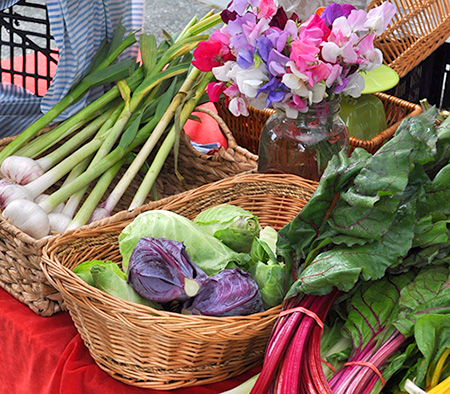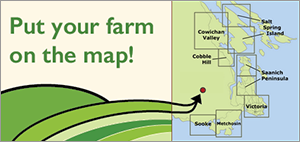Can Local Agriculture Drive Economic Development?
Surrey Study Shows What is Possible
 British Columbians often give several reasons why local food is the best choice for everyone: Locally grown food tastes better, has greater nutritional value, protects the environment, strengthens genetic diversity, and develops the local economy. The last point raises an important question. How much can local agriculture do for a local economy?
British Columbians often give several reasons why local food is the best choice for everyone: Locally grown food tastes better, has greater nutritional value, protects the environment, strengthens genetic diversity, and develops the local economy. The last point raises an important question. How much can local agriculture do for a local economy?
A comprehensive study released in 2013 by the Institute for Sustainable Food Systems at Kwantlen Polytechnic University delivered a definitive answer—local agriculture can do a lot.
The study began in 2010 when the City of Surrey commissioned the Institute to assess specific ways to increase agricultural use of Surrey’s Agricultural Land Reserve (ALR). If readily available but underutilized ALR land were turned into small-scale agriculture, how much additional food could be produced? What kind of economic development would result from this local agriculture? How much money and how much employment?
Local Agricultural Land in Surrey
Surrey, a city of a half million people, sits in the Greater Vancouver Lower Mainland in BC. Encompassing 316 square kilometres of fertile Fraser River Valley land, it enjoys some of the best climatic and soil conditions in all of Canada. The city has a long and significant agricultural history which continues to this day. Currently, Surrey is home to a diversified agriculture that includes berries, vegetables, dairy, beef, poultry, and numerous greenhouse operations.
 In the 1950s and 60s, Surrey and the surrounding area suburbanized rapidly. “Minimum lot size” zoning provisions led to a highly fragmented agricultural land base. The extensive subdivision of large farm parcels encouraged residences and other nonfarm uses on rural land. By the early 1970s, British Columbians became alarmed that some of the province’s best farmland would soon be covered by suburban sprawl.
In the 1950s and 60s, Surrey and the surrounding area suburbanized rapidly. “Minimum lot size” zoning provisions led to a highly fragmented agricultural land base. The extensive subdivision of large farm parcels encouraged residences and other nonfarm uses on rural land. By the early 1970s, British Columbians became alarmed that some of the province’s best farmland would soon be covered by suburban sprawl.
In 1973, the Agricultural Land Commission Act created protected agricultural lands known as the Agricultural Land Reserve (ALR) throughout the province. The Act placed approximately one-quarter (86 square kilometres) of Surrey’s total land area into the agricultural land reserve.

The Study—Surrey’s Underutilized ALR Lands
Using conservative criteria, aerial photographs, visual inspections, and careful field work, the Institute for Sustainable Food Systems determined that 13.2 square kilometres (1,320 hectares) or 15 percent of Surrey’s total ALR could successfully be used for small-scale farming.
With the most productive underutilized areas delineated, the researchers applied existing successful small-scale agricultural models to determine what this program could produce for Surrey.
The results were dramatic.
The models demonstrated that if this 15 percent of Surrey’s underutilized ALR land were brought into small-scale agricultural production, it could satisfy 100 percent of Surrey’s consumption of 27 vegetables, fruits and animal products for six months of the year. The 27 crops include potatoes, eggs, apples, lettuce, onions, tomatoes, carrots, cabbage, cucumbers, table grapes and more. This new production could contribute over $183 million to Surrey’s economy and create as many as 1,600 new full-time equivalent jobs. (Article continues below video.)
Video: How Underutilized Agricultural Land Can Feed a City
A Self-Sustaining Regional Food System
 The Institute for Sustainable Food Systems’ groundbreaking analysis for Surrey produced revolutionary implications. Employing only a small percentage of its underutilized ALR land, the study showed, Surrey could double the economic value of its large agriculture sector, create 1,600 jobs, and hundreds of new food-related businesses. The city could become self-sufficient in a broad range of healthy foods for at least six months of the year—and with likely follow-on food processing businesses, for the entire year.
The Institute for Sustainable Food Systems’ groundbreaking analysis for Surrey produced revolutionary implications. Employing only a small percentage of its underutilized ALR land, the study showed, Surrey could double the economic value of its large agriculture sector, create 1,600 jobs, and hundreds of new food-related businesses. The city could become self-sufficient in a broad range of healthy foods for at least six months of the year—and with likely follow-on food processing businesses, for the entire year.
 The Institute for Sustainable Food Systems study of Surrey’s Underutilized ALR Lands provides a compelling road map for economic development. Following its recommendations, Surrey could dramatically reduce its dependence on imported crops from California’s drought-stricken Central Valley. This would greatly enhance food security for Greater Vancouver, and decrease the region’s carbon footprint for food production. With suburban and developer pressure on underutilized ALR lands throughout the province, the study provides a model for reclaiming local agriculture and developing prosperous and sustainable regional economies in the 21st century.
The Institute for Sustainable Food Systems study of Surrey’s Underutilized ALR Lands provides a compelling road map for economic development. Following its recommendations, Surrey could dramatically reduce its dependence on imported crops from California’s drought-stricken Central Valley. This would greatly enhance food security for Greater Vancouver, and decrease the region’s carbon footprint for food production. With suburban and developer pressure on underutilized ALR lands throughout the province, the study provides a model for reclaiming local agriculture and developing prosperous and sustainable regional economies in the 21st century.

Map by Parthi Krishnan, PhD, Department of Geography, Kwantlen Polytechnic University
Related articles:
 Profitable and Ecological Small-Scale Farming
Profitable and Ecological Small-Scale Farming
 Why Farmland Protection is Not Enough
Why Farmland Protection is Not Enough
 How We Can Regrow Sustainable Agriculture in BC
How We Can Regrow Sustainable Agriculture in BC
 Who Are the 21st Century Farmers?
Who Are the 21st Century Farmers?













yes that is SO TRUE!! However the problem is finding enough healthy, strong, young people who are prepared to work long hard hours to grow the food and then sell the food at affordable prices!!!! I live in Metchosin near Victoria on Vancouver Island. it is a small rural community with some viable farmland and yet even here much of that land remains fallow because there are not enough people to farm it. What young person, except for the few very dedicated ones, would want to work in a field (pardon the unintended pun) that requires many hours of hard work for very little return?